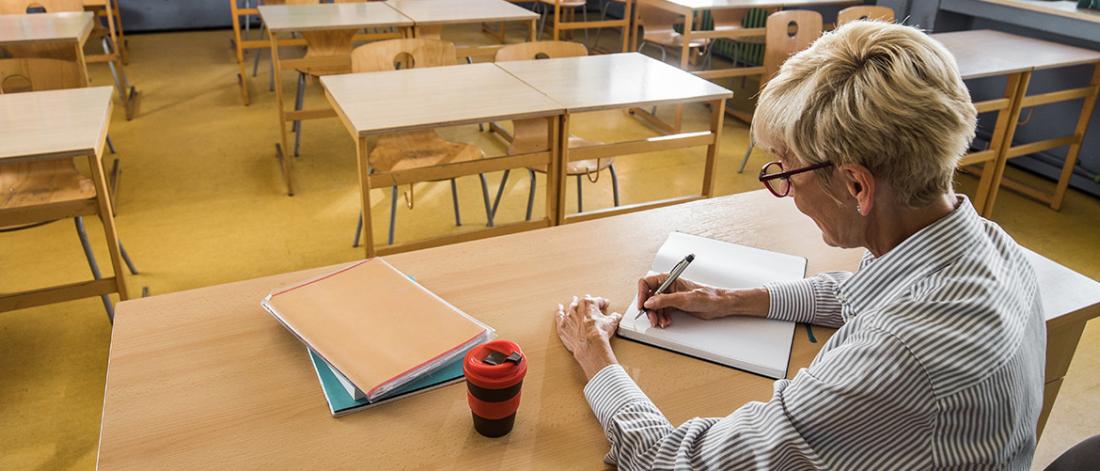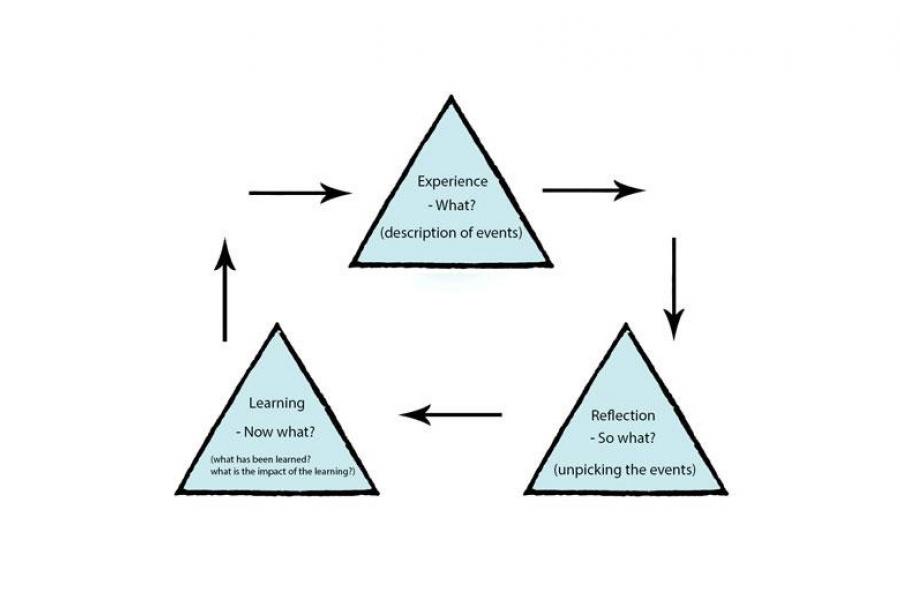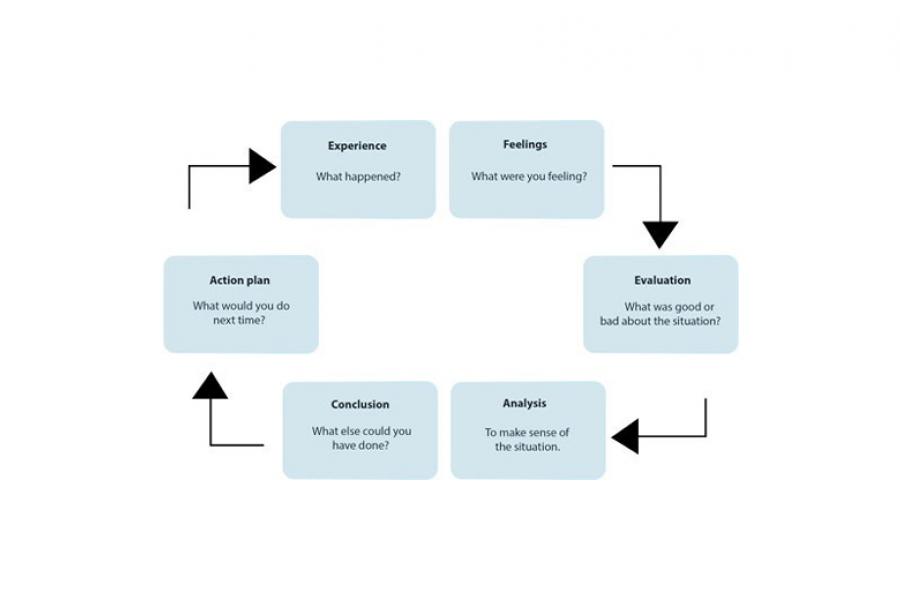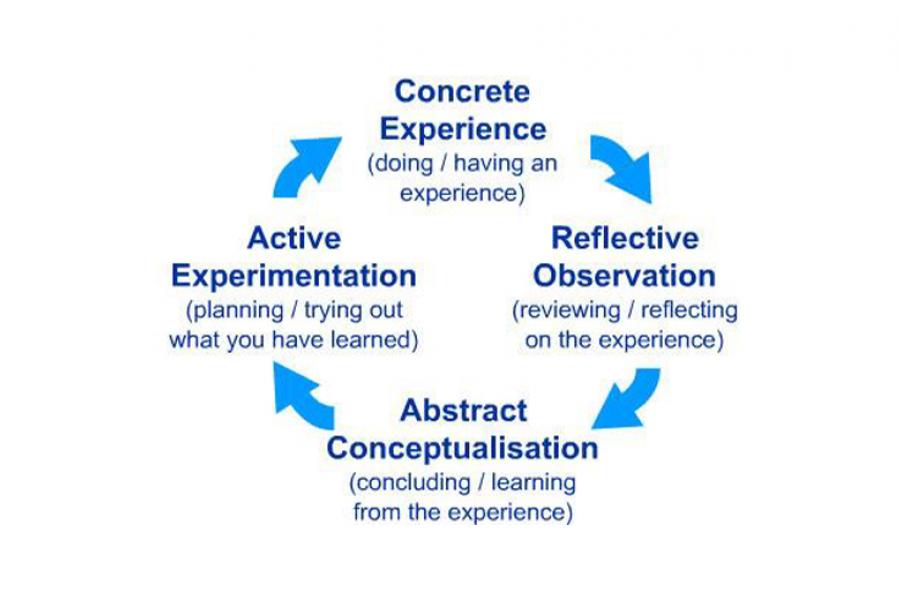Reflective teaching
A reflective practice is a self-study in which we consider alternatives to our actions, with an awareness of our own biases about teaching, about ourselves and about our students.

Introduction
There is no happiness if the things we believe in are different than the things we do. — Albert Camus

What is a reflective practice?
In a nutshell, a reflective practice is a self-study in which we consider alternatives to our actions, with an awareness of our own biases about teaching, about ourselves, and about our students. Barriers to reflection may include fear of judgement, fear of criticism, being closed to feedback, defensiveness, personal biases, & professional arrogance.
Many faculty members already think about their teaching and talk to colleagues about it. You might think or tell someone that, “My lecture went well” or “My students didn’t seem to understand” or “My students were so distracted today.” Without spending time spent focusing on what has happened, we may tend to jump to conclusions. ‘It’s not me, it’s them.” We may also only notice reactions of the louder students. Reflective teaching therefore implies a more systematic process of collecting, recording, and analyzing our thoughts and observations, as well as those of our students, and then going on to making changes.
A reflective practice is at the heart of professional development. If we want to get better at our teaching practice then we need a framework to guide us. Through such a structure, if a lesson went well we can describe it and take the time to think deeply about why it was successful. If the students didn’t understand a point we introduced we need to spend some time and think about what we did and why it was unclear.
Models of reflection
There are many different models of reflection as a quick search online will prove. Using models, or at least being aware of their similarities and differences, can help you to deconstruct experiences, ensure you are accessing the deeper level reflective questions and issues, and ultimately provide a way to structure your learning from situations.
Boud’s Triangular Representation
Many models are cyclical in nature, representing the idea that reflection leads to learning, but this learning is never completed or able to be transferred without reflecting on it further in different contexts. The most simple model could be seen to be Boud’s triangular representation, Figure 2.

This model, although capturing the essentials (that experience and reflection lead to learning), has limitations. It doesn’t guide us as to what reflection might consist of, or how the learning might translate back into experience. Aligning key reflective questions to this model, see Figure 3, may help.

Gibb’s Reflective Cycle
Alternatively, other theorists have broken down the cycle into further stages, an example of which is Gibb’s reflective cycle, see Figure 4.

Gibb’s model acknowledges that your personal feelings influence the situation and how you have begun to reflect on it. It builds on Boud’s model by breaking down reflection into evaluation of the events and analysis and there is a clear link between the learning that has happened from the experience and future practice.
However, despite the further break down, it can be argued that this model could still result in fairly superficial reflection as it doesn’t refer to critical thinking / analysis or reflection. It doesn’t take into consideration assumptions that you may hold about the experience, the need to look objectively at different perspectives, and there doesn’t seem to be an explicit suggestion that the learning will result in a change of assumptions, perspectives or practice. You could legitimately respond to the question ‘What would you do next time?’ by answering that you would do the same, but does that constitute deep level reflection?
Atkins and Murphy model
Atkins and Murphy (1993) address many of these criticisms with their own cyclical model, see Figure 5.

Murphy and Atkins’ model can be seen to explicitly support the kind of deeper level reflection that was discussed earlier in this course. This is not to say that the other models aren’t useful, far from it, but that it is important to remain alert to the potential to provide superficial responses as the critical, questioning and challenging elements of critical reflection are not as explicit.
Source: Learning to teach: Becoming a reflective practitioner. The Open University.
Experiential learning and reflective teaching
Kolb: Four Stages of Experiential Learning
“Experiential learning theory defines learning as the process whereby knowledge is created through the transformation of experience. Knowledge results from the combination of grasping and transforming experience.” (Kolb, 1984)
Kolb’s experiential learning theory is represented as a four stage cyclical process of learning. These stages are: concrete experience, reflective observation, abstract conceptualization and active experimentation (Kolb, Boyatzis & Mainemelis, 1999; McLeod, 2010).
Concrete Experience: This is the first step of the experiential learning process. Concrete Experience sees the learner involved in a new experience or situation. This also includes a reinterpretation of an existing experience.
Reflective Observation: The second step of Kolb’s theory, reflective observation, involves systematic reflection on the new experience. This is an analytical step in which the learner consciously thinks about what they have just experienced. A particularly important aspect of this step is the realization of inconsistencies between experience and understanding.
Abstract Conceptualization: The learner delves deeper into their thinking about the subject. In this step, the learner constructs a new idea, or modifies an existing concept to explain their observations.
Active Experimentation: The final step of the process involves using these new theories to solve problems and make decisions. By applying their newly-conceived understanding of the world around them, they are demonstrating their newfound knowledge. The process enters a new cycle when the learner uses this experimentation to create a new Concrete Experience.
In essence, effective experiential learning occurs when:
- The learner has a concrete experience
- The learner reflects upon their new experience
- The learner analyzes their reflections and observations and creates their own conclusions
- The learner uses these conclusions to test future situations
After the fourth step, the process repeats itself on new experiences. For effective experiential learning to take place, the whole cycle must be completed, in the order described. (McLeod, 2010)
The Process of Reflective Teaching
Reflective teaching is a form of self-assessment (Brookfield, 1995; Gore & Zeichner, 1991; Kuit et al., 2001). It is a method of improving teaching skills by means of metacognitive awareness. Through reflection and making conscious efforts to evaluate one’s current abilities, continuous improvements can be made in honing one’s teaching abilities.
There are many reflective teaching strategies with parallels to Kolb’s Four Stages of Experiential Learning Theory. Many of them can be conceptually split into four sections similar to Kolb’s four stages of Concrete Experience, Reflective Observation, Abstract Conceptualization and Active Experimentation.
For example, common strategies of reflective teaching include:
- Keeping a teaching journal
- Peer Observation
- Recording lessons
- Student feedback
You may begin a process of reflection in response to a particular problem that has arisen in one of your classes, or simply as a way of finding out more about your teaching. You may decide to look at a feature of your teaching – for example how you deal with incidents of incivility (‘bad’ student behaviour) or how you can encourage your students to be more engaged in your class.
The first step is to gather information about what happens in the class. Here are a few suggestions:
- Teaching journal
This is the easiest way to begin a process of reflection since it is purely personal. After each teaching session you head back to your office and write about what happened. You may describe your own reactions and feelings and those you observed on the part of the students. Posing questions about what you observed can be helpful. Journal writing does require a bit of discipline in taking the time to do it on a regular basis. - Peer observation
Invite a colleague to come into your class to collect information about your lesson. This may involve a simple observation task or merely note taking. A peer observation will ideally relate back to the area you have identified to reflect upon. For example, you might ask your colleague to focus on which students contribute most in the session, what different patterns of interaction occur, or how you deal with errors. - Recording lessons
Video or audio recordings of lessons can provide very useful information for reflection. You may do things in class you are not aware of or there may be things happening in the class that as the teacher you do not normally see. Audio recordings can be useful for considering aspects of teacher talk. Video recordings can be useful in showing aspects of your own behaviour. - Student feedback
You can also ask your students what they think about what goes on in the classroom. Their opinions and perceptions can add a different and valuable perspective. This can be done with simple questionnaires or a muddiest point exercise, for example.
What to do next
Once you have gathered some information about what goes on in your classroom, what do you do?
- Think
You may have noticed patterns occurring in your teaching through your observation or you may also have noticed things about your teaching that you were previously unaware of. Your students’ feedback may surprise you or confirm what you have already suspected. Ideas for changes to try out may begin to form. - Talk
Just by talking about what you have discovered – to a supportive colleague or even a friend – you may be able to come up with some ideas for how to do things differently.
You can meet to discuss issues of concern with colleagues who also wish to develop their teaching. Discussion can be based around scenarios from your own classes. - Read
You may decide that you need to find out more about a certain area. We have access to many resources through the Centre’s library and the university’s extensive library.
Reflective teaching is a cyclical process, because once you start to implement changes, then the reflective and evaluative cycle begins again. As a result of your reflection you may decide to do something in a different way, or you may just decide that what you are doing is the best way. Reflective practice is at the heart of our professional development and becoming a better teacher.
*Adapted from: Tice, J. (2004). Reflective teaching: Exploring our own classroom practice.
Using Reflection to improve student learning
- Critical incident analysis (Gibbs’ model) – this is what happened, this is how I felt, this is how I evaluate & make sense of the situation, this is what I could have done, this is what I’ll do next time
- Quick write/One minute paper – assessing prior knowledge, analyzing, what happened last class… next class
- Muddiest point – this is what I know so far, this is what is unclear…
- Reflective writing – Engaging with the ideas: how does this relate to my own ideas and experience
Another example of a tool for student engagement is the DEAL model developed by Patti Clayton. The assignment is guided by specific prompting questions that encourage students to complete these various tasks in their reflective writing, from the who, what, when and where of an experience (describing learning) to more detailed prompts about what was learned and how (examining and articulating learning).
Deal Model
- Describe the experience
- Examine the experience in light of specific learning objectives
- Articulate the Learning
Describe
List concepts discussed in this workshop
Examine
- Prompt #1: What does each of these concepts mean, in your own words?
- Prompt #2: Provide an example of each of the concepts as it does or could emerge in your teaching.
- Prompt #3: Draw a concept map to represent the relationships between these concepts, with labels, arrows, etc. on the lines connecting the concepts to one another
- Prompt #4: What new dimensions/nuances do you now see in any of the concepts? What questions does this lead you to (about any of the concepts)?
- Prompt #5: What is the most significant change in your understanding of the concepts?
Articulate Learning
- I learned that…
- I learned this when…
- This learning matters because…
- In light of this I will…
Source: Ash & Clayton (2009). DEAL Model for Critical Reflection.
Resources and references
Atkins, S. and Murphy, K. (1993) ‘Reflection: a review of the literature’, Journal of Advanced Nursing, vol. 18, pp. 1188–1192.
Bolton, G. (2014). Reflective practice: Writing and professional development (4th ed.). Los Angeles, CA: Sage.
Boud D, Keogh R & Walker D (1985) Reflection: Turning experience into learning. Kogan Page, London.
Brookfield, S. D. (1995). Becoming a critically reflective teacher. San Francisco, CA: Jossey-Bass.
Chickering, A. W. & Ehrmann, S. (1996). Implementing the seven principles: Technology as a lever.
Davis, B. (2009). Tools for teaching (2nd ed., Jossey-Bass higher and adult education series). San Francisco, CA: Jossey-Bass.
Ghaye, T., & Ghaye, T. (2011). Teaching and learning through reflective practice a practical guide for positive action (2nd ed.). London: Routledge.
Gibbs, G. (1988) Learning by doing: a guide to teaching and learning methods. Oxford: Further Education Unit.
Gore, J. M., & Zeichner, K. M. (1991). Action research and reflective teaching in preservice teacher education: A case study from the United States. Teaching and teacher education, 7(2), 119-136.
Kolb, D.A., Boyatzis, R.E., Mainemelis, C. (1999). Experiential Learning Theory: Previous Research and New Directions. Case Western Reserve University
Kolb, D.A. (1984). Experiential Learning: Experience as the Source of Learning and Development, Englewood Cliffs, NJ: Prentice Hall
Moon, J. (1999). Reflection in learning & professional development: Theory & practice. London: Kogan Page.
Moon, J. (2004). A handbook of reflective and experiential learning theory and practice. London: RoutledgeFalmer.
Nilson, L. (2016). Teaching at its best: A research-based resource for college instructors, (4th ed.) San Francisco, CA: Jossey-Bass.
Palmer, P. (2007). The courage to teach: Exploring the inner landscape of a teacher’s life (10th anniversary ed.). San Francisco, CA: Jossey-Bass.
Schon, D. (1995). Knowing-in-Action: The New Scholarship Requires a New Epistemology. Change, 27(6), 26-34.
Schon D (1983). The Reflective Practitioner. Basic Books, London.
Stevens, D., & Cooper, J. (2009). Journal keeping how to use reflective writing for effective learning, teaching, professional insight, and positive change. Sterling, Va.: Stylus Pub.
Taylor, B. (2006).Reflective Practice for Healthcare Professionals. New York: McGraw-Hill.
Tice, J. (2004). Reflective teaching: Exploring our own classroom practice.
Zull JE. 2002. The Art of Changing the Brain. Stylus, Sterling, VA.
